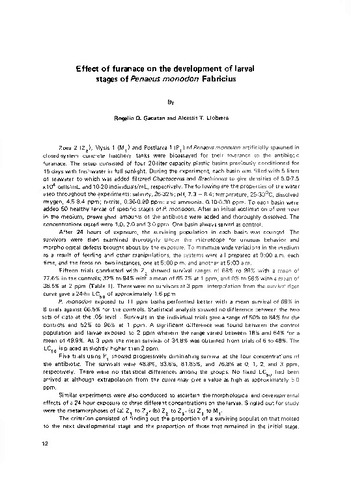Effect of salinity on the osmotic, chloride, total protein and calcium concentrations in the hemolymph of the prawn Peneaus monodon (Fabricius)
- Global styles
- MLA
- Vancouver
- Elsevier - Harvard
- APA
- Help

閲覧/開く
日付
1986Page views
2,140ASFA keyword
AGROVOC keyword
Taxonomic term
Metadata
アイテムの詳細レコードを表示するCited times in Scopus
- Citations
- CrossRef - Citation Indexes: 59
- Policy Citation - Policy Citations: 1
- Scopus - Citation Indexes: 72
- Captures
- Mendeley - Readers: 24
Share
抄録
1. Osmolality and chloride concentrations in the hemolymph of Penaeus monodon became stable 1 day after molting in 32 ppt, while total protein and calcium concentrations remained stable throughout the molting cycle. When intermolt (≥ 36 hr postmolt) animals were transferred from control (32 ppt) to experimental (8–40 ppt) salinities, osmolality, chloride and total protein, but not calcium, concentrations in the hemolymph achieved steady state values 24–48 hr after transfer.
2. The hemolymph osmolality was a linear function (slope = 0.28) of medium osmolality at salinities between 8 and 40 ppt. It was isosmotic to seawater at 698 mOsm (10 g prawns) and 752 mOsm (30 g), and was hyperosmotic to the medium below isosmotic concentrations, and hypoosmotic to those above.
3. Hemolymph chloride concentration was isoionic to seawater at 334 mM, and was hyperregulated below isoionic concentrations, and hyporegulated to those above.
4. P. monodon maintained its hemolymph calcium concentration between 6.4 and 10 mM when medium salinities increased from 8 to 40 ppt.
5. Total protein concentration in the hemolymph was independent of medium salinity (8–40 ppt) and hemolymph osmolality (540–850 mOsm).
記述
SEAFDEC Aquaculture Department Contribution No. 159.
Suggested Citation
Ferraris, R. P., Parado-Estepa, F. D., Ladja, J. M., & de Jesus, E. G. (1986). Effect of salinity on the osmotic, chloride, total protein and calcium concentrations in the hemolymph of the prawn Peneaus monodon (Fabricius). Comparative Biochemistry and Physiology - Part A: Physiology , 83(4), 701-708. https://doi.org/10.1016/0300-9629(86)90713-9
Type
ArticleISSN
0300-9629Collections
- Journal Articles [1247]
Related items
Showing items related by title, author, creator and subject.
-
Luminous Vibrio and the greenwater culture of the tiger shrimp Penaeus monodon with tilapia
Lio-Po, Gilda D. (John Wiley & Sons, Ltd, 2017)Luminous vibriosis is a devastating infection of penaeid shrimp larvae and juveniles causing heavy mortalities. To counter the bacterial pathogen, Vibrio harveyi, shrimp farmers in the Philippines modified their growout ...66 Total citations0 Recent citations0.91 Field Citation Ration/a Relative Citation Ratio
-
A suctorean parasite of Penaeus monodon larvae
Gacutan, Rogelio Q.; Llobrera, Alcestis T.; Santiago, Corazon B.; Gutierrez, P. J.; Lio, Gilda (Aquaculture Department, Southeast Asian Fisheries Development Center, 1977)A new disease caused by a suctorean has been observed in tank-spawned and reared P. monodon larvae. Identification of the etiologic agent pointed to Ephelota gemmipara R. Hertwig, a species commonly found to inhabit hydroid ... -
Effect of furanace on the development of larval stages of Penaeus monodon Fabricius
Gacutan, Rogelio Q.; Llobrera, Alcestis T. (Aquaculture Department, Southeast Asian Fisheries Development Center, 1977)Zoea 2 (Z2), Mysis 1 (M1) and Postlarva 1 (P1) of P. monodon artificially spawned in closed-system concrete hatchery tanks were bioassayed for their tolerance to the antibiotic furanace. ...






